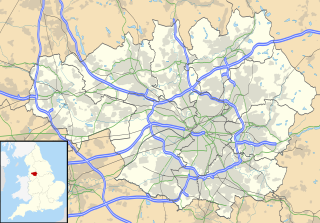History
In July 1899 a legal agreement was signed for the purchase of 2,000 square yards of land at a cost of £900 on Wheler Street, Higher Openshaw, as a site for a new Moravian church. This was the result of several years of outreach by members of the Moravian Settlement at Fairfield in nearby Droylsden. Indeed, the location had been the site of the Edge Lane preaching station as long ago as the 1850s.
An iron structure was erected and furnished on the land at a cost of £400. This building was 44 feet long and 24 feet wide and could accommodate nearly 220 people. At the street end, there was a porch with two side entrances. At the back was a small vestry. The church had four windows on each side and a small rose window at the porch end. At the vestry end, on a raised platform, stood the communion table and a desk. [1]
The new building was opened for worship on 16 November 1899, with public services taking place on 26 November and 3 December. [2] The Minister of Fairfield at the time, who led this work of outreach, was Br Samuel Kershaw.
Average attendance in the first month stood at eighty. Within five years, some two hundred people attended Sunday School. An extra building was erected in 1912. Wheler Street was the first Moravian congregation in the United Kingdom to have a Scout Troop. In 1920, Sir John Purser Griffith donated more than £2,000 to clear the building loans still outstanding on Wheler Street and three other Moravian churches. [3] At one time, over twenty groups had regular weekly meetings at the church. By 1929 a brick church had been erected and the iron structure was finally demolished in 1964. A new extension followed in 1967.

Sir John Purser Griffith was a Welsh-born Irish civil engineer and politician.
In the 110 years of its existence, the congregation had thirty ministers. Three of these went on to become bishops. Two men of Wheler Street acknowledged a call to ordained ministry and became Moravian ministers, Brn D Dickinson and D Howarth.
In its final years, the congregation had an average membership of about thirty people. Declining membership, demographic change and costs of further development prompted a decision to close the congregation in 2009. [1]

Droylsden is a town in Greater Manchester, England, 4.1 miles (6.6 km) east of Manchester city centre and 2.2 miles (3.5 km) west of Ashton-under-Lyne, with a population at the 2011 Census of 22,689.

The Moravian Church, formally named the Unitas Fratrum, in German known as [Herrnhuter] Brüdergemeine, is one of the oldest Protestant denominations in the world, with its heritage dating back to the Bohemian Reformation in the 15th century and the Unity of the Brethren established in the Kingdom of Bohemia.
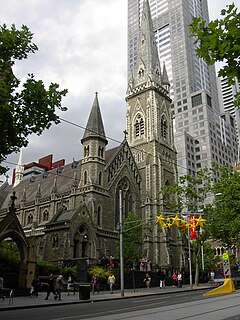
The Scots' Church is a Presbyterian church in Melbourne, Australia. It was the first Presbyterian church to be built in the Port Phillip District and is located on Collins Street. It is a congregation of the Presbyterian Church of Australia and has been described as "an icon for well over a hundred years".
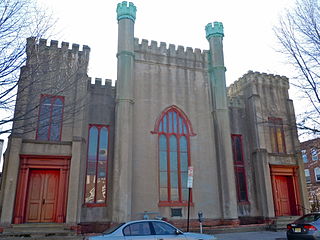
Established in 1703, St. Michael's Church in downtown Trenton, Mercer County, New Jersey, United States, is a founding parish of the Episcopal Diocese of New Jersey. Its present building located at 140 North Warren Street was built in 1747–1748, and was renovated in 1810 and 1847–1848. It was listed on the National Register of Historic Places on April 29, 1982 as St. Michael's Episcopal Church.

The British Province of the Moravian Church is part of the worldwide Moravian Church Unity.
The Jamaica Province of the Moravian Church is part of the worldwide Moravian Church Unity.

The Hunter Baillie Memorial Presbyterian Church is a heritage–listed church of the Presbyterian denomination, located in the inner western Sydney suburb of Annandale, New South Wales, Australia.

The First Free Will Baptist Church and Vestry are an historic Free Will Baptist Church complex at 57 Main Street in Ashland, New Hampshire. The complex consists of three buildings: the brick church building, which was built in 1834; the old vestry, a brick building standing near the street which was built c. 1835 as a school and converted to a vestry in 1878; and the new vestry, a wooden structure added in 1899 to join the two brick buildings together. The church, a fine vernacular Federal style building when it was built, had its interior extensively restyled in the late 19th and early 20th centuries. The complex was listed on the National Register of Historic Places in 1983, primarily as a good example of modest Victorian church architecture. It now houses the Ashland Community Church.

Westwood Moravian Church was founded in 1865 in the Westwood area of Oldham, in Greater Manchester, England. By 1868 the church building was too small for its congregation, and a new structure was opened in 1869. This church was used for Moravian services until 2005 when the congregation sold it and moved to its new premises in Royton. The Westwood building still stands.

Bethabara Moravian Church is a congregation of the Jamaica Province of the Moravian Church. It opened for worship on 1841-07-28.

Fairfield Moravian Church and its surrounding settlement was founded in 1785 in Fairfield, Droylsden, Lancashire, England. It was founded by Benjamin La Trobe as a centre for evangelistic work for the Moravian Church in the Manchester area. Numbers 15, 28 and 30 Fairfield Square are Grade II* listed buildings.
Salem Moravian Church was founded in Oldham, Lancashire, England in 1825 by John Lees. Br Lees, who lived in the Clarksfield area of Oldham, was associated with the Moravian Settlement at Fairfield in Droylsden.
Dukinfield Moravian Church was founded in Dukinfield, Cheshire, England in 1755 following a period of evangelistic work in the area by Moravians from 1742. It now stands within the Tameside Metropolitan Borough, Greater Manchester.
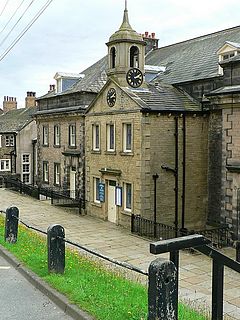
Fulneck Moravian Church and its associated settlement were established on the Fulneck estate, Pudsey, in the West Riding of Yorkshire, England, in 1744 by Count Nicolaus Ludwig von Zinzendorf, a Moravian Bishop and Lutheran priest, following a donation of land by the evangelical Anglican clergyman, Benjamin Ingham. Fulneck is now part of the City of Leeds, West Yorkshire.

Trinity Moravian church houses a congregation of the Jamaican province of the Moravian Church. It was established in 1954 as part of the bicentenary celebrations of the Moravian Church in Jamaica.
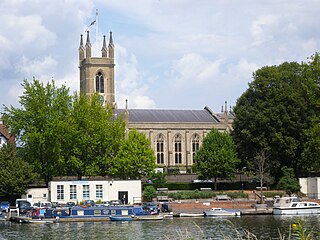
St Mary's Parish Church, Hampton, is an Anglican church in Hampton in the London Borough of Richmond upon Thames.
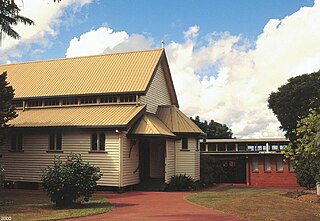
Christ Church is a heritage-listed church at 24 Macrossan Street, Childers, Bundaberg Region, Queensland, Australia. It was designed by John Hingeston Buckeridge and built from 1900 to 1958. It is also known as the Anglican Church. It was added to the Queensland Heritage Register on 28 April 2000.
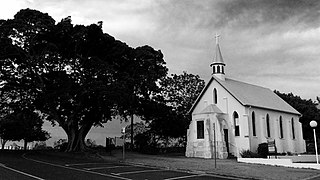
St Pauls Anglican Church is a heritage-listed church at Cross Street, Cleveland, City of Redland, Queensland, Australia. It was designed by James Furnival and built in 1873; it was extended in 1924 to a design by Lange Leopold Powell. It was added to the Queensland Heritage Register on 21 October 1992.

St Andrews Church is a heritage-listed Anglican church at Wellington Street, Ormiston, City of Redland, Queensland, Australia. It was built c. 1868. It was added to the Queensland Heritage Register on 21 October 1992.

St Saviour's Anglican Church is a heritage-listed former church building at 26 Hynes Street, South Johnstone, Cassowary Coast Region, Queensland, Australia. It was built from 1938 to 1939 by Mose Romano. It was added to the Queensland Heritage Register on 24 September 2004.
